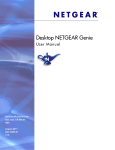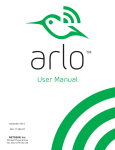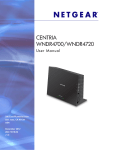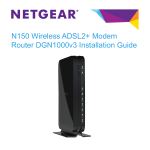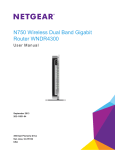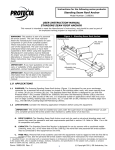Download NETGEAR Centria WNDR4700/WNDR4720 Installation Guide
Transcript
Technical Support Package Contents Thank you for selecting NETGEAR products. For indoor use only in all EU countries and Switzerland. After installing your device, locate the serial number on the label of your product and use it to register your product at www.NETGEAR.com/register. Registration is required before you can use our telephone support service. Registration through our website is strongly recommended. Centria WNDR4700/WNDR4720 Installation Guide The box contains the following items. If any items are incorrect, missing, or damaged, contact your NETGEAR dealer. Note: Only Model WNDR4720 includes a hard disk drive (HDD). Go to http://support.netgear.com for product updates and web support. Tray HDD (WNDR4720) Centria Ethernet cable NETGEAR, Inc. 350 East Plumeria Drive San Jose, CA 95134, USA July 2012 Power adapter Note: Your hard disk drive was shipped external to Centria to protect it from any accidental damage. Please do ensure when shipping Centria to always remove the hard drive from the internal slot. You can use this diagram to cable and connect your router or follow the detailed instructions in this booklet. Compliance Declarations of Conformity 1. Prepare your modem. For complete DoC visit the NETGEAR EU Declarations of Conformity website at: http://support.netgear.com/app/answers/detail/a_id/11621/. For GNU General Public License (GPL) related information, visit http://support.netgear.com/app/answers/detail/a_id/2649 Unplug your modem. If it has a battery backup, remove the battery. 3. Insert a hard disk drive (optional). 2. Connect your modem. Plug in your modem. Put the battery back in. Then cable the modem to the router Internet port. DSL or Cable Router 4. Power on the router. Internet Modem 5. Connect a computer 6. Launch a browser. This symbol is placed in accordance with the European Union Directive 2002/96 on the Waste Electrical and Electronic Equipment (the WEEE Directive). If disposed of within the European Union, this product should be treated and recycled in accordance with the laws of your jurisdiction implementing the WEEE Directive. Contents Getting to Know Your Router . . . . . . . . . . . . . . . . . . . . . . . . . . 4 Install Your Router . . . . . . . . . . . . . . . . . . . . . . . . . . . . . . . . . . . 6 1. Prepare your modem. . . . . . . . . . . . . . . . . . . . . . . . . . . . 6 2. Connect your modem. . . . . . . . . . . . . . . . . . . . . . . . . . . 6 4. Power on the router. . . . . . . . . . . . . . . . . . . . . . . . . . . . . 7 5. Connect a computer. . . . . . . . . . . . . . . . . . . . . . . . . . . . 8 6. Launch a browser. . . . . . . . . . . . . . . . . . . . . . . . . . . . . . 8 Install an HDD (Optional) . . . . . . . . . . . . . . . . . . . . . . . . . . . . . . 9 Format the HDD . . . . . . . . . . . . . . . . . . . . . . . . . . . . . . . . . . . 10 Remove a Hard Disk Drive (HDD). . . . . . . . . . . . . . . . . . . . . . 10 Preset Wireless Security . . . . . . . . . . . . . . . . . . . . . . . . . . . . . 12 Wireless Network Settings . . . . . . . . . . . . . . . . . . . . . . . . 13 Join the Wireless Network . . . . . . . . . . . . . . . . . . . . . . . . . . . . 14 WPS Method. . . . . . . . . . . . . . . . . . . . . . . . . . . . . . . . . . . 14 Manual Method . . . . . . . . . . . . . . . . . . . . . . . . . . . . . . . . . 14 Access the Router to Make More Changes. . . . . . . . . . . . . . . 15 Change Your Password . . . . . . . . . . . . . . . . . . . . . . . . . . 16 Retrieve Your Password . . . . . . . . . . . . . . . . . . . . . . . . . . 16 Format the HDD from the Router Menu . . . . . . . . . . . . . . 17 Troubleshooting. . . . . . . . . . . . . . . . . . . . . . . . . . . . . . . . . . . . 17 ReadySHARE Access . . . . . . . . . . . . . . . . . . . . . . . . . . . . . . . 18 ReadySHARE Vault App . . . . . . . . . . . . . . . . . . . . . . . . . . . . . 18 ReadySHARE Printer . . . . . . . . . . . . . . . . . . . . . . . . . . . . . . . 19 NETGEAR genie App . . . . . . . . . . . . . . . . . . . . . . . . . . . . . . . . 20 NETGEAR genie Mobile App . . . . . . . . . . . . . . . . . . . . . . 21 1 Getting to Know Your Router Most connectors are on the rear panel. Power connector USB LAN ports 1-4 Power On/Off Restore Factory Settings WAN (Internet) port The following figure shows the front and side panel. WPS WiFi On/Off Backup USB port Card reader LEDs The router has buttons on the side and LEDs on the front • WPS. Use WPS to add a wireless computer or device to the network. • WiFi On/Off. Turn the wireless radios on and off. • Backup. Press for 2 seconds to back up files on a card attached to the card reader onto the HDD inside the router. • USB 3.0 port. Connect a USB device • Card reader. Connect an SD, MMC, MS, or MS Pro type card. 4 Table 1. LEDs LED Description Power • Solid amber. The router is starting up. • Blinking amber. The firmware is upgrading, or the Restore Factory Settings button was pressed. • Solid green. The router is ready. • Blinking green. The firmware is corrupted. See www.netgear.com/support. • Off. Power is not supplied to the router. Internet • Solid green. The Internet connection is ready. • Solid amber. The Ethernet cable connection to the modem has been detected. • Off. No Ethernet cable is connected to the modem. Wireless • Solid blue. The wireless radio is operating in either 2.4 GHz or 5 GHz mode. • Blinking: The router is in WPS mode. • Off. The wireless radios are off for both 2.4 GHz and 5 GHz. USB • Solid blue: The router has accepted the USB device. The USB device is ready to be used. • Blinking blue: A USB HDD is plugged in and is trying to connect. • Off: No USB device is connected, someone clicked the Safely Remove Hardware button and it is now safe to remove the attached USB device. HDD • Solid green: The internal HDD is working fine; • Solid green plus red: The HDD is 85% full. • Blinking green: Someone pressed the Backup button; SD card data is being copied to the internal HDD. • Blinking green and red: The HDD is 95% full. • Solid red: The HDD is not formatted, the HDD connection is loose, or failure alert. • Off: No internal HDD is connected. 5 Install Your Router Make sure that your Internet service is active before you install the router. Follow steps 1 through 5. 1. Prepare your modem. a. Unplug your modem’s power. b. If the modem has a battery backup, remove its batteries. c. If your modem was already connected to another router, disconnect the cable between your modem and that router. Now your modem should be turned off and cabled only to the wall jack for your Internet service. 1 DSL or cable Internet Modem 2. Connect your modem. 2 Router b a Modem a. Plug in and turn on your modem. (Replace the batteries if you removed them previously.) b. With the yellow Ethernet cable that came with the router, connect your modem to the Internet port of your router. 6 3. Install a hard disk drive (optional). 3 For details, see Install an HDD (Optional) on page 9. 4. Power on the router. On/Off Router 4 Modem a. Connect the power adapter to the router and plug the power adapter into an outlet. b. Before going to Step 5, wait for the Wireless LED on the front panel of the router to turn on. If none of the LEDs on the front panel are on, press the Power On/Off button on the rear panel of the router. 7 5. Connect a computer. Router Modem 5 You can use an Ethernet cable (not included) or connect wirelessly. • Use the Ethernet cable to connect your computer to an Ethernet port on your router. • Or, connect wirelessly by using the preset wireless security settings located on the label on the bottom of the router. 6. Launch a browser. • If a web page does not open, close and reopen the browser and type http://routerlogin.net in the address bar or see Troubleshooting on page 17. 6 • If you installed an HDD, you can format it when prompted, or do that later. • During installation, you can download and install the ReadySHARE Vault app, or do that later. ReadySHARE Vault lets you manage your backups from your computer. See ReadySHARE Vault App on page 18. 8 Install an HDD (Optional) You can install a hard disk drive (HDD) in the router. The router supports both 1-inch and 0.75-inch SATA HDDs. To install a hard disk drive: 1. Make sure the router is turned off. 2. Open the router side door and move the internal latch down as shown. This allows you to insert the HDD. 3. If you are installing a 0.75-inch HDD, insert the tray into the router. Follow the THIS SIDE UP and the BACK OF PRODUCT signs on the tray to place it in the correct orientation. 9 4. Insert the HDD. The SATA interface is up. 5. Close the latch to secure the HDD place. 6. Close the side door of the router. Note: If the latch is not in the correct position or the HDD is inserted in the wrong direction, then the side door to the router cannot be closed. If the internal HDD is not formatted, the HDD LED turns red. Format the HDD If you install the HDD during your initial router setup, the router detects it and prompts you to format the HDD. You can follow the prompts to do so, or wait until later and log in to the router to format the HDD from the router menu. See Format the HDD from the Router Menu on page 17. Remove a Hard Disk Drive (HDD) To remove the HDD: 1. Make sure that the router is turned off. 10 2. Open the router side door and release the internal latch as shown. 3. Grab the top and bottom of the HDD with your fingers and pull to remove it. 4. If you removed a 0.75-inch HDD, remove the tray from the router. 5. Be sure to place the latch back to the left so that the router side door can be closed. 11 Preset Wireless Security This product has a unique WiFi network name (SSID) and network key (password). The default SSID and network key (password) are uniquely generated for every device, like a serial number, to protect and maximize your wireless security. This information is on the label on the bottom of the product. NETGEAR recommends that you do not change the preset WiFi network name (SSID) and network key (password). If you do change the settings, the security SSID and password on the bottom of the product no longer apply. 12 Wireless Network Settings Record the default preset wireless settings that are printed on the label in the space below for easy reference. WiFi Network Name (SSID): Network Key (Password): If you change the default settings, record them here for easy reference, and then store this booklet in a safe place: WiFi Network Name (SSID): Network Key (Password): To retrieve or update your wireless password, type www.routerlogin.net in a web browser and log in using the default user name (admin) and password (password). Select Wireless Settings to locate your wireless password. 13 Join the Wireless Network Choose the WPS method or the manual method to join your wireless network. WPS Method Wi-Fi Protected Setup (WPS) lets you connect to a secure WiFi network without typing its password. Instead, you press a button or enter a PIN. NETGEAR calls WPS Push 'N' Connect. Some older WiFi equipment is not compatible with WPS. WPS works only with WPA2 or WPA wireless security. To use WPS to join the wireless network: 1. Press the WPS button on the side of the router. 2. Within 2 minutes, press the WPS button on your wireless computer or device, or follow the WPS instructions that came with the device. The WPS process sets up your wireless computer with the network password, and connects you to the wireless network. Manual Method With the manual method, you choose the network that you want, and type its password to connect. To connect manually: 1. On your computer or wireless device, open the software that manages your wireless connections. This software scans for all wireless networks in your area. 2. Look for your network and select it. The unique WiFi network name (SSID) and password are on the router’s label. If you changed these settings, then look for the network name that you set up. 3. Enter the router password and click Connect. 14 Access the Router to Make More Changes After you use NETGEAR genie to set up the router, you can log in to the router to view or change its settings. To log in to the router: 1. Launch a web browser from a computer or wireless devices that is connected to the router. 2. Type www.routerlogin.net or www.routerlogin.com in the address field of the browser. A login screen displays: admin ******** 3. Enter admin for the user name and password for the password. The router Basic Home screen displays: See the User Manual for more information about the router screens. 15 Change Your Password To change the password for the router user name: 1. Log in to the router. 2. Select Administration > Set Password to display the Set Password screen: 3. Type your old password and type the new password twice. NETGEAR recommends that you use the password recovery feature when you change your password. 4. Select the Enable Password Recovery check box. 5. You are prompted to select security questions and type the answers, which are saved. 6. Click Apply. Retrieve Your Password To use password recovery to retrieve a forgotten password: You need to enable password recovery as described in the previous section in order to use this feature. 1. Launch a web browser from a computer or wireless device that is connected to the router. 2. Type www.routerlogin.net or www.routerlogin.com in the address field of the browser. 3. When the login screen displays, click Cancel. You are prompted to enter your saved answers so that you can log in to the router. 16 Format the HDD from the Router Menu 1. Select Advanced > Storage > Advanced Settings. 2. Click the Format Internal Hard Drive button. Troubleshooting If you turn off the router when an HDD is installed, wait 2 seconds before turning it back on to give the HDD enough time to reset. If the HDD LED is red and it used to be green, the HDD connection could be loose. Turn off the router. Disconnect the HDD, and then connect it again. Turn the router on and check the HDD LED. If the browser does not display the web page: • Make sure that the computer is connected to one of the four LAN Ethernet ports, or wirelessly to the router. • Make sure that the router has power and that the WiFi LED is lit. • Close and reopen the browser to make sure that the browser does not cache the previous page. • Type http://routerlogin.net. • If the computer is set to a static or fixed IP address (this is uncommon), change it to get its IP address from the router. 17 ReadySHARE Access After installation and setup, you can insert a USB storage device into the USB port on the router and share the contents with other network users. (If your USB device has special drivers, it is not compatible.) Note: If your USB device requires a power supply, you must use it when connecting your USB device to a NETGEAR router or gateway. It might take up to 2 minutes before the USB drive is ready for sharing after it is connected to the router. To access your internal HDD or a USB device: On Windows systems, use any of these methods: • Select Start > Run and enter \\readyshare in the dialog box. Click OK. • Open Explorer or Safari and enter \\readyshare in the address bar. • Open My Network Places and enter \\readyshare in the address bar. On Mac systems, do this: 1. Select Go > Connect to Server. 2. Enter smb://readyshare as the Server Address. 3. Click Connect. The readyshareconnect.exe file (for Windows) is available to download here: www.netgear.com/readyshare. ReadySHARE Vault App ReadySHARE Vault lets you easily back up files from your Windows computer onto a hard disk drive (HDD) inside your router or to a USB disk attached to the router USB port. To learn about ReadySHARE Vault or to download and install it, visit www.netgear.com/readyshare. 18 ReadySHARE Printer ReadySHARE Printer lets you connect a USB printer to the router’s USB port, and access it wirelessly. To set up ReadySHARE Printer: 1. Connect the USB printer to the router’s USB port with a USB printer cable. 2. On each computer that will share the printer: a. Install the current USB printer driver software (available from the printer manufacturer). b. Download and install the NETGEAR USB Control Center utility (available in the ReadySHARE Printer area at (www.netgear.com/readyshare). c. Select the language. 3. If prompted, select the printer and click the Connect button for each computer. Once the connection is established on the first computer, the status changes to Manually connected by xxx. The utility on each computer handles the printing queue. After you have completed step 3 for all computers, the status of the printer should appear as Available on each computer. • The USB Control Center utility must be running for the computer to print to the USB printer attached to the router. If you exit the utility, printing does not work. • Some firewall software, such as Comodo, blocks the ReadySHARE Print utility from accessing the USB printer. If you do not see the printer in the utility, you can disable the firewall temporarily to allow the utility to work. For information about using ReadySHARE Printer, see the User Manual by clicking the Documentation link in the router management interface or on the Support website (http://support.netgear.com). 19 NETGEAR genie App The genie app is your home network dashboard. It lets you easily view, manage, and control your entire home network, and helps you fix common network problems. You can use the genie app or the genie mobile app. Internet WiFi Connection Router Settings STATUS GOOD STATUS Connected Click here Network Map Parental Controls ReadySHARE Number of devices 16 Click here Click here genie app Visit the NETGEAR genie web page at: www.netgear.com/genie. From the genie app, you can do the following: • Internet. Monitor and repair Internet connectivity issues for both wired and wireless connections. • WiFi Connection. View or change your router wireless settings. • Router Settings. Log in to your router to view or change its settings. • Network map. View network devices connected to your network. • Parental Controls. Manage parental controls to protect devices in your network from inappropriate content. • ReadySHARE. If you connected a USB storage device or printer to the USB port on the router, then you can access its contents. • Support. Support FAQs are available on your computer without an Internet connection. You can get answers to common router issues here. Some simple network tools are available to help you debug the network as well. 20 NETGEAR genie Mobile App To install the genie mobile app: 1. Use your mobile device to navigate to the Apple AppStore or Google Play for Android, and search for NETGEAR genie. You can use the following QR codes to speed up this process: iPad App iPhone App Android App 2. Install the app on your iPad or phone. 3. Launch the app, and it displays the dashboard screen. To use this app, you need a WiFi connection from your phone or iPad to your NETGEAR home network. • Manage WiFi settings and guest access for your home network. • View a map of your network. • Set up or manage Parental Controls. • Use Traffic Meter to check your Internet usage. • With My Media, play media on devices on your network. 21 © 2012 NETGEAR, Inc. All rights reserved. No part of this publication may be reproduced, transmitted, transcribed, stored in a retrieval system, or translated into any language in any form or by any means without the written permission of NETGEAR, Inc. DO NOT stack equipment, or place equipment in tight spaces or in drawers. Be sure that your equipment at least 2 inches (5 cm) of air space. Trademarks NETGEAR, the NETGEAR logo, and Connect with Innovation are trademarks and/or registered trademarks of NETGEAR, Inc. and/or its subsidiaries in the United States and/or other countries. Information is subject to change without notice. Other brand and product names are registered trademarks or trademarks of their respective holders. Statement of Conditions In the interest of improving internal design, operational function, and/or reliability, NETGEAR reserves the right to make changes to the products described in this document without notice. NETGEAR does not assume any liability that may occur due to the use or application of the product(s) or circuit layout(s) described herein. 22




























